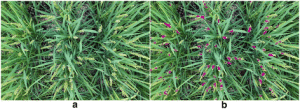
A sense of smell…
 In the latest addition of ‘Mark my words’ in Investigative Genetics, Mark Jobling (University of Leicester, UK) looks at genetic and evolutionary aspects of smell. Jobling gives an overview of the homozygous mutations making some humans – unfortunately – more scented than others, and also how genetics have illuminated population differences in odor via the seemingly unrelated subject of earwax. This comment summarizes that scent enriches our lives, despite not being of high importance to our survival.
In the latest addition of ‘Mark my words’ in Investigative Genetics, Mark Jobling (University of Leicester, UK) looks at genetic and evolutionary aspects of smell. Jobling gives an overview of the homozygous mutations making some humans – unfortunately – more scented than others, and also how genetics have illuminated population differences in odor via the seemingly unrelated subject of earwax. This comment summarizes that scent enriches our lives, despite not being of high importance to our survival.
… and taste
 It is currently accepted that there are five primary tastes: sweet, salt, sour, bitter and umami. However, a growing body evidence, as reviewed in Keast and Costanzo’s new article published in Flavour, now suggests that fat should be considered as the sixth taste primary.
It is currently accepted that there are five primary tastes: sweet, salt, sour, bitter and umami. However, a growing body evidence, as reviewed in Keast and Costanzo’s new article published in Flavour, now suggests that fat should be considered as the sixth taste primary.
Considering that our taste systems have evolved to detect nutrients or toxins in food prior to ingestion, perhaps it is not surprising that our taste systems would detect essential energy-dense macronutrients such as fats. What is of particular interest in chemosensory and nutrition research is whether “fat taste” sensitivity (or lack thereof) may be linked with dietary consumption of fatty foods and the development of obesity.
Decreased sensitivity to fat taste, for example, has in fact now been associated with increased consumption of fatty foods in both animal and human studies, whereas hypersensitivity, as you might expect, has been linked to decreased consumption and fat aversion.
Speaking of food…
Bread wheat (Triticum aestivum) is the most widely grown and consumed crop in the world, providing nutrition for 30% of the global population. Besides its agronomical importance, its large, allohexaploid, and highly repetitive genome makes it a good model for studying complex genomes. Lise Pingault and colleagues examine in Genome Biology the mechanisms by which genes are organized on wheat chromosome 3B, how they are regulated, and what this tells us about wheat genome evolution.
Observing flowering time in rice is an important but very time-consuming and labor-intensive process. In the journal Plant Methods, Guo and colleagues have developed a method for automatically counting flowering panicles of paddy rice in photographic images taken under natural field conditions. Using time-series images it is possible to follow diurnal changes and identify daily peaks of flowering.

Viewing Africa differently
 The New Partnership for Africa’s Development (NEPAD) strategy article in Biotechnology for Biofuels examines how bioenergy technology could enable sustainable development. The article explores how bioenergy production can be an agent of socioeconomic transformation in Africa.
The New Partnership for Africa’s Development (NEPAD) strategy article in Biotechnology for Biofuels examines how bioenergy technology could enable sustainable development. The article explores how bioenergy production can be an agent of socioeconomic transformation in Africa.
The article helps overcome the perception that Africa lacks the resources to pursue bioenergy (its arable land potential is huge) and also explains how fuel production can be part of a plan to intensify agriculture in a sustainable way, in synergy with improved food production.
Malaria control programs rely on accurate disease risk maps to ensure that they are effective. Malaria endemicity varies over space and time, depending on fluctuating environmental factors, and so to successfully map disease risks, you have to be able assess these environmental factors accurately. Daniel Weiss and colleagues, in their article in Malaria Journal, have identified a set of environmental covariates that will produce more reliable risk maps of Plasmodium falciparum malaria.
Finally, the secrets of the little brain

A wealth of current evidence has brought to the fore that the cerebellum is not only implicated in sensorimotor function but also plays a cardinal role in the modulation of cognitive and affective processes.
In 1998, Dr Jeremy Schmahmann’s work pioneered the role of the cerebellum in cognition and emotion, in reporting a complex constellation of cognitive and affective deficits following cerebellar disease, first described as cerebellar cognitive affective syndrome (CCAS).
In Cerebellum & Ataxias, leading experts in the field, Mario Manto and Peter Mariën put this new syndrome into the context of cerebellar evaluation for clinicians, introducing ‘Schmahmann’s syndrome’, the identification of the third milestone in clinical ataxiology.
- Scientists of the future: Matteo Gregori discusses his research path into Arctic microbiology - 22nd February 2022
- Scientists of the Future: Rebecca Ansorge talks to us about her research on the gut microbiome - 10th February 2022
- Quiz: so you think you know biology? - 6th October 2018
One Comment